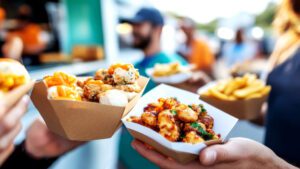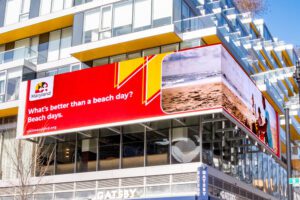What started as an old-school marketing move is now becoming fuel for viral moments. The perfect example? When Chappell Roan dropped her single “The Giver,” she didn’t take the usual route of just uploading it to streaming platforms and announcing it on social media. Instead, her team did something totally unexpected. They put up quirky billboards in key cities featuring a fake job opening and a real phone number. Fans who called got to hear snippets of the new song—and couldn’t wait to share their experience online.
This is a perfect example of what’s being called “the analog edge“—using creative offline strategies to stand out in an overwhelming digital world. For marketers in food, beverage and hospitality, this hybrid strategy can deliver both emotional resonance and measurable ROI.
Insights on Analog Advertising Approaches
The tactile, surprising nature of real-world experiences can be a breath of fresh air in a hyper-digital age. Nearly 50% of global consumers report spending too much time online, and one-third feel digital overload, according to Holmen’s Trend Tracker Report. Physical activations like clever direct mail, creative billboards or pop-up experiences provide a moment of surprise and delight that is increasingly rare in digital campaigns.
Analog marketing not only feels fresh and personal, but it’s also a great pathway to emotional engagement. Handwritten notes, physical mailers and even nostalgic items evoke a sense of intimacy and care. Forrester Consulting’s study with PFL noted that physical touchpoints like direct mail were expected to see a 27% investment increase in 2023, with marketers leveraging their ability to stand out and create lasting impressions.
More Marketing Success: Chappell’s Not Alone
Artists like Chappell Roan aren’t the only ones tapping into traditional media. See how brands are creatively blending analog and digital strategies to drive engagement and sales:
- Liquid Death turned heads with vending machines in skateparks and clubs, creating viral social buzz and even selling the machines to superfans as a new revenue stream.
- Hidden Valley Ranch tapped into nostalgia with plush toys and storybooks sent to superfans and influencers, sparking user-generated content and boosting holiday sales.
- Marriott Bonvoy combined utility and creativity with QR-embedded billboards in high-traffic locations, rewarding travelers with perks like room upgrades and driving shareable moments.
Why Does Analog Work for Food, Beverage and Hospitality Brands?
1. These Industries Live in the Real World
Dining, traveling and hospitality are inherently sensory and tactile experiences. Analog marketing mirrors those moments of joy, offering a touchpoint that feels authentic to how customers interact with these categories. Whether it’s a branded food truck for a summer launch or postcards placed in hotel rooms, these activations resonate organically.
2. Easy to Localize and Personalize
Analog tactics can be tailored to regional audiences while directly engaging local communities. Think custom hotline numbers, limited-edition share-worthy packaging, or fun out-of-home advertising—like Visit Maryland’s summer campaign billboards featuring insider messaging for people who live in the state or nearby.
3. Enhances Digital Storytelling
Analog moments are inherently shareable. Whether it’s a neon billboard, a surprise-filled mailer or an exclusive pop-up, these physical experiences encourage consumers to document and share them across social platforms, amplifying organic buzz.
Measuring Digital Success Beyond Likes and Views
The fusion of analog and digital tactics delivers measurable ROI—when executed thoughtfully. The key? Smart tracking and clear KPIs. To accurately measure the impact of your campaigns, focus on these tools and key metrics:
- Unique Touchpoints: Track campaigns using custom phone numbers, QR codes or landing pages. Monitor data capture like email sign-ups, SMS opt-ins and survey responses.
- Social Listening: Keep tabs on mentions, shares, user-generated content (UGC) and posts surrounding your activations. Compare engagement rates to baseline digital-only campaigns.
- Earned Media Metrics: Measure press coverage, its influence on search trends and overall brand visibility. Assess brand recall through sentiment surveys and emotional impact studies.
- Local Sales Lift: Analyze sales growth in regions targeted by out-of-home (OOH) efforts for a direct link to campaign performance.
Marketing Strategy is Everything
The intersection of analog and digital isn’t just about nostalgia for simpler times; it’s about creating meaningful experiences that cut through the noise. These touchpoints should align with your brand story while delivering measurable outcomes. Want to cut through the noise with a campaign that people will remember? Reach out to David Melnick to reimagine what’s possible for your brand.
Sources:
Trend Tracker Report Uncovers Increasing Digital Fatigue. Holmen, 2023.
Failing to Acknowledge Digital Fatigue Will Be a Fatal Marketing Flaw in 2023. PFL, January 2023.
